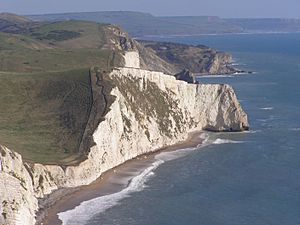Upper Jurassic facts for kids
The Upper Jurassic was the final part of the Jurassic Period, a very long time ago! It started about 163.5 million years ago and finished around 145 million years ago. Imagine, that's a huge stretch of time when dinosaurs roamed the Earth! After the Upper Jurassic, the Lower Cretaceous Period began. This was a time of big changes for our planet, especially with how the continents were shaped and where the oceans were.
Contents
Earth's Changing Map
During the Upper Jurassic, the supercontinent called Pangaea continued to break apart. Think of Pangaea as one giant landmass that covered much of the Earth. It split into two main parts: Laurasia in the north and Gondwana in the south.
This massive breakup led to the birth of the Atlantic Ocean. At first, the Atlantic was quite narrow, like a small river compared to the huge ocean we know today. Over millions of years, it grew much wider.
Ancient Seas and Rocks
Sea levels were quite high during this time, though not as high as they would be later in the Upper Cretaceous. The rising seas turned the northern landmass of Laurasia into many large islands.
The rocks formed during this epoch were mostly carbonate limestones and clays. One very famous rock formation from this period is the Solnhofen Limestone in Germany. This special limestone is known for preserving amazing fossils, like the very first bird, Archaeopteryx.
Life Flourished in the Upper Jurassic
The Upper Jurassic period was full of life, especially in places like England and Europe. The Kimmeridge Clay, a type of rock from this time, is super important. It's the main source for the huge North Sea oil reserves we use today. This shows just how much ancient life was buried and changed into oil over millions of years.
Fossils Everywhere
This entire epoch is packed with marine fossils. Scientists have found countless remains of sea creatures from the Upper Jurassic. Many dinosaur remains have also been discovered, giving us clues about these incredible animals.
The period started with the Oxford Clay being laid down. This happened in a shallow seaway, which was only about 10 to 50 meters deep. Imagine a vast, warm, shallow sea teeming with ancient life!
Feathered Dinosaurs Appear
It was also during the Upper Jurassic that we find the first fossils showing small dinosaurs with feathers. One of these early feathered dinosaurs was named Anchiornis. Finding these fossils was a big deal because it helped scientists understand how birds might have evolved from dinosaurs.
Related pages
See also
 In Spanish: Jurásico Superior para niños
In Spanish: Jurásico Superior para niños


